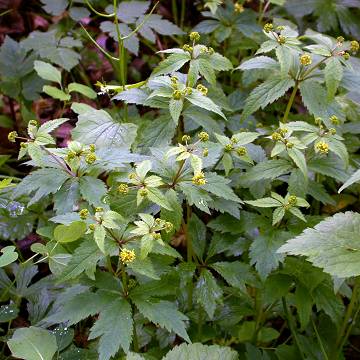

Sanicula odorata - (image 1 of 5)
Taxonomy
Family: Apiaceae
Synonymous with S. gregaria E.P. Bicknell
Habitat
Woodlands, shaded floodplains, usually with some degree of disturbance. Can become a weed of shaded gardens.
Associates
In woodlands with Crataegus mollis, Crataegus punctata, Fraxinus americana, Parthenocissus quinquefolia, Prunus serotina, Prunus virginiana, Quercus rubra, Ribes missouriense, Sambucus canadensis, Tilia americana, Ulmus americana, Vitis riparia. Herbaceous associates in disturbed woodlands include Agrimonia gryposepala, Arisaema triphyllum, Claytonia virginica, Cryptotaenia canadensis, Galium aparine, Geranium maculatum, Geum canadense, Osmorhiza claytonii, Phlox divaricata, Phryma leptostachya, Polygonatum canaliculatum, Ranunculus abortivus, Ranunculus septentrionalis, Smilacina racemosa, Smilax lasioneura.
Distribution
Nova Scotia and Quebec west to MN and eastern SD, south FL to TX.
Morphology
Herbaceous perennial. Flowers greenish-yellow; sepals of staminate flowers deltoid-lanceolate, less than 1 mm long; styles conspicuous, much longer than the bristles, recurving back over the fruit. Ovaries and fruits short-stipitate (on a stipe). Plants typically with a yellow-green appearance.
Notes
Flowers early May to mid August
Wetland indicator: FAC
Most other members of this genus have greenish-white flowers rather than greenish-yellow.
References
Gleason, Henry A. and A. Cronquist. 1991. Manual of Vascular Plants of Northeastern United States and Adjacent Canada. Second Ed.
The New York Botanical Garden. Bronx, NY
Swink, F. and G. Wilhelm. 1994. Plants of the Chicago Region.
Indiana Academy of Science. The Morton Arboretum. Lisle, Illinois.
|
Michael Hough © 2005 |